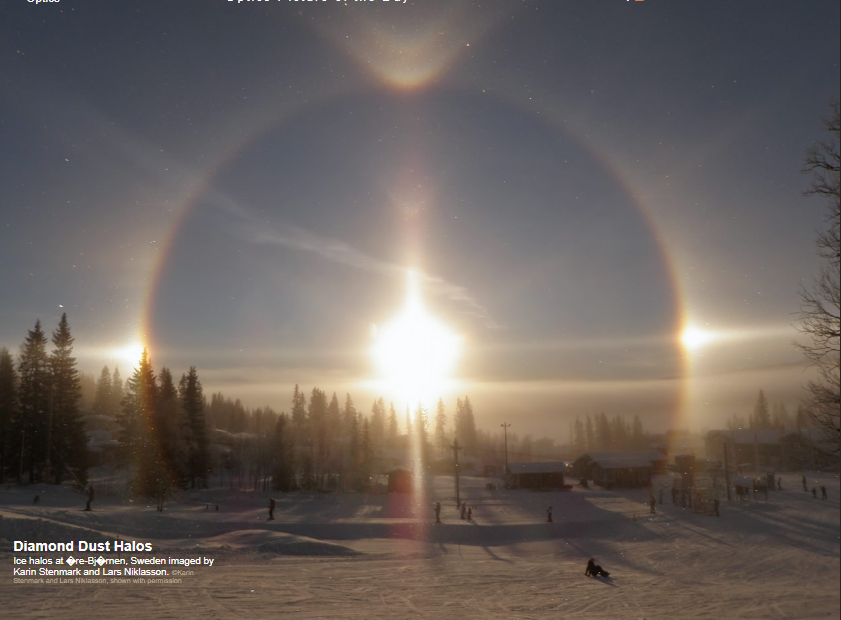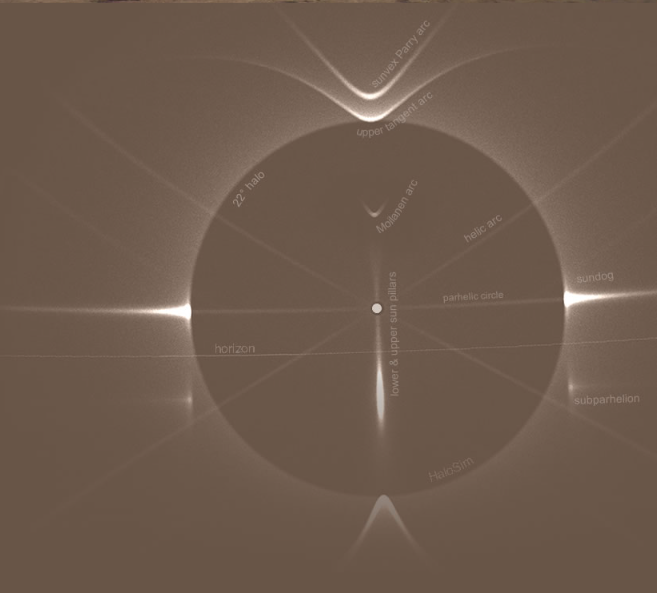OPOD - Sweden Halos
OPOD - Sweden Halos: A Dazzling Display of Atmospheric Optics
In the enchanting winter wonderland of Sweden, a mesmerizing phenomenon known as diamond dust halos takes center stage. The stunning images captured by Karin Stenmark and Lars Niklasson at Åre-Björnen showcase the intricate beauty of ice halos, where arcs and mock-suns tower over and even shine among the skiers.
The magic of diamond dust halos lies in the interplay between sunlight and ice crystals. These halos are created when sunrays are refracted and reflected by hexagonal prism ice crystals, resulting in precise curves and circles that astound the onlooker. The geometric perfection of these ice crystals contributes to the symphony of optical wonders displayed in the Swedish sky.
What makes diamond dust halos particularly fascinating is their origin. While they are often found in ski areas, these displays are not solely a creation of snow machines. Rather, they arise naturally, with snow machines playing a small role in their formation. The process begins when snow machines spray out tiny particles, including enzymes, to act as nuclei for snow growth. Some of these nuclei escape and serve as seeds for the natural growth of halo-forming crystals, which can travel several kilometers downwind. These crystals boast superb optical quality, further enhancing the brilliance of the halos.
While most of the halos observed in Sweden can be explained by their formation process, there is one exception - the faint V-shaped arc immediately over the sun, known as a Moilanen arc. Its origin remains a mystery that continues to puzzle scientists. In an attempt to shed light on this enigmatic phenomenon, HaloSim, a simulation tool, was used to recreate the Moilanen arc using a 37° prism. However, this artificial simulation still falls short of fully explaining its occurrence.
The frequency of halos in Sweden varies, with some being rare, others not so rare, and a few even occurring frequently. These optical displays add a touch of magic to the wintry landscape, captivating both locals and visitors alike. To fully appreciate the wonder of Sweden's halos, it is essential to witness them firsthand and immerse oneself in their ethereal beauty.
In conclusion, the diamond dust halos observed in Sweden's ski areas are a testament to the awe-inspiring complexity of atmospheric optics. The interplay between sunlight and ice crystals gives rise to geometrically precise halos that illuminate the sky with their enchanting allure. While their origin can be partially attributed to snow machines, these displays are ultimately a natural phenomenon, with the ice crystals possessing exceptional optical quality. Although most halos can be explained by scientific understanding, the enigmatic Moilanen arc remains a captivating mystery. The varying frequency of these halos adds an element of surprise and anticipation to the wintry landscape. To truly appreciate the splendor of Sweden's halos, one must experience them firsthand and marvel at the harmonious dance between light and ice in the sky above.

Diamond Dust Halos
Ice halos at �re-Bj�rnen, Sweden imaged by Karin Stenmark and Lars Niklasson. ©Karin Stenmark and Lars Niklasson, shown with permission

Arcs and mock-suns tower over and even shine among the skiers. Diamond dust, nearby ice crystals, made this. Geometry begets geometry. The precise curves and circles are creations of sunrays refracted and reflected by even more precisely figured hexagonal prism ice crystals...
Diamond dust makes the best halos and ski areas have some of the best diamond dust. The crystals are a by-product of snow machines yet we should not be disappointed at this lowly origin for the displays are natural. Only a seed speck inside each ice crystal is courtesy of the ski slope. Snow machines spray out small particles, sometimes an enzyme, to act as nuclei for snow growth. Some nuclei escape and instead seed the natural growth of halo forming crystals up to several kilometres downwind. The crystals are oft of superb optical quality.
..We are certain of this for all but one of these halos, the faint V-shaped arc immediately over the sun, a Moilanen arc, whose origin is not yet explained. It was simulated in HaloSim at right using a rather artificial 37° prism.
The halos - rare - not so rare - frequent:
Note: this article has been automatically converted from the old site and may not appear as intended. You can find the original article here.
Reference Atmospheric Optics
If you use any of the definitions, information, or data presented on Atmospheric Optics, please copy the link or reference below to properly credit us as the reference source. Thank you!
-
<a href="https://atoptics.co.uk/blog/opod-sweden-halos/">OPOD - Sweden Halos</a>
-
"OPOD - Sweden Halos". Atmospheric Optics. Accessed on November 26, 2024. https://atoptics.co.uk/blog/opod-sweden-halos/.
-
"OPOD - Sweden Halos". Atmospheric Optics, https://atoptics.co.uk/blog/opod-sweden-halos/. Accessed 26 November, 2024
-
OPOD - Sweden Halos. Atmospheric Optics. Retrieved from https://atoptics.co.uk/blog/opod-sweden-halos/.